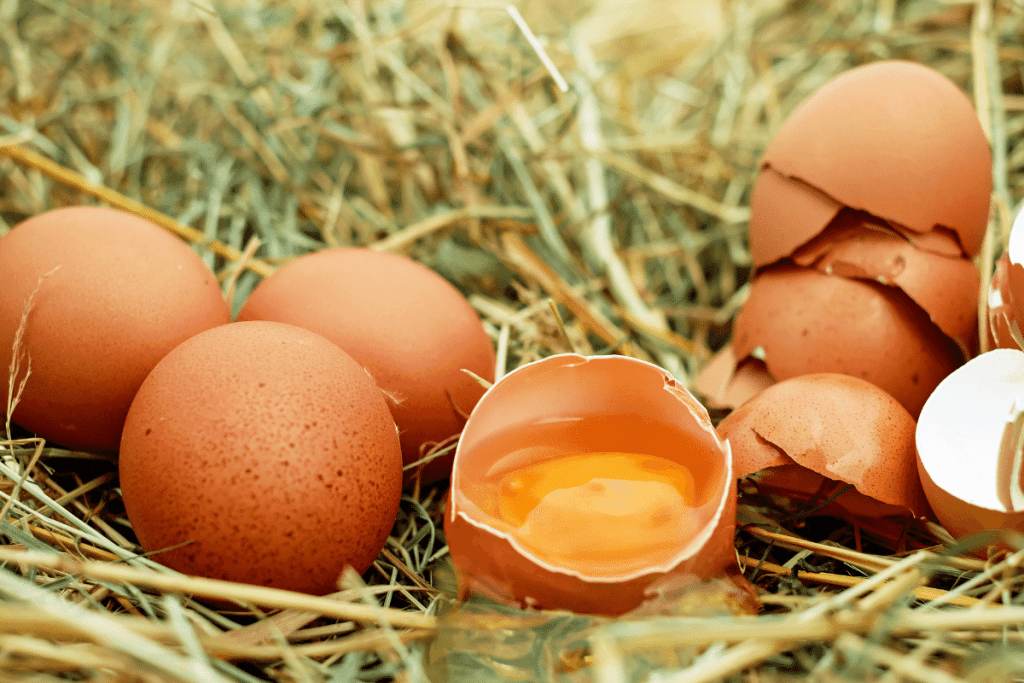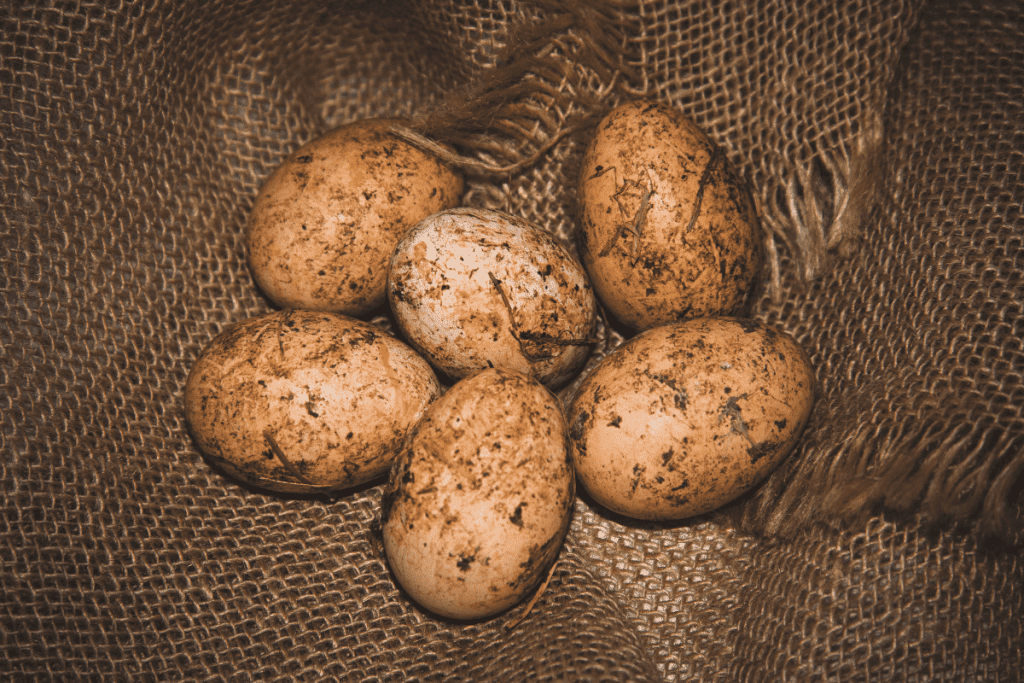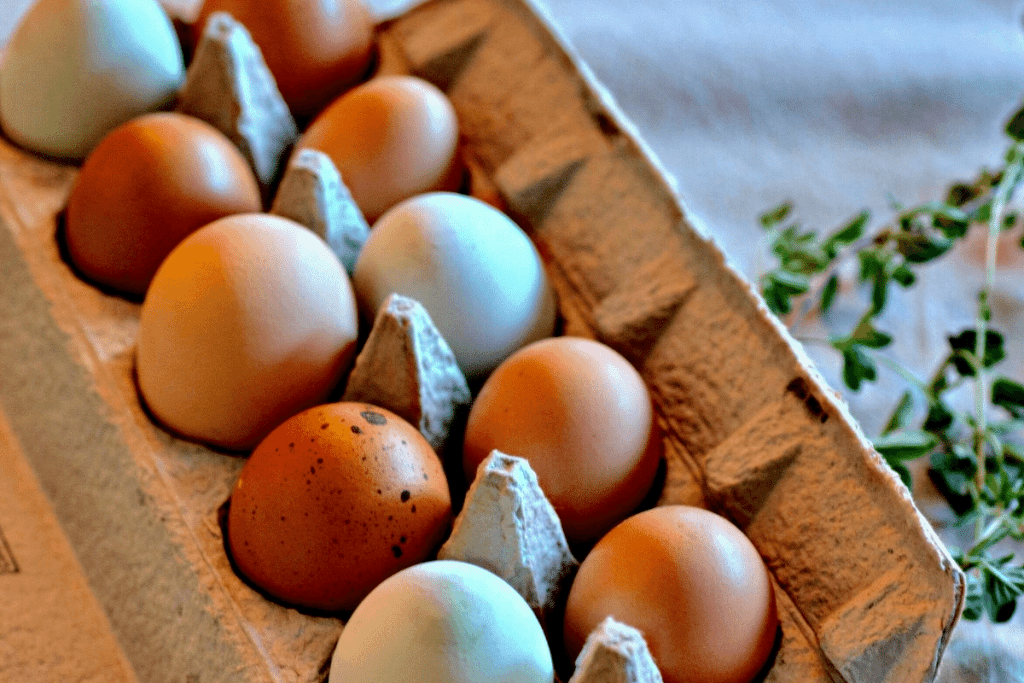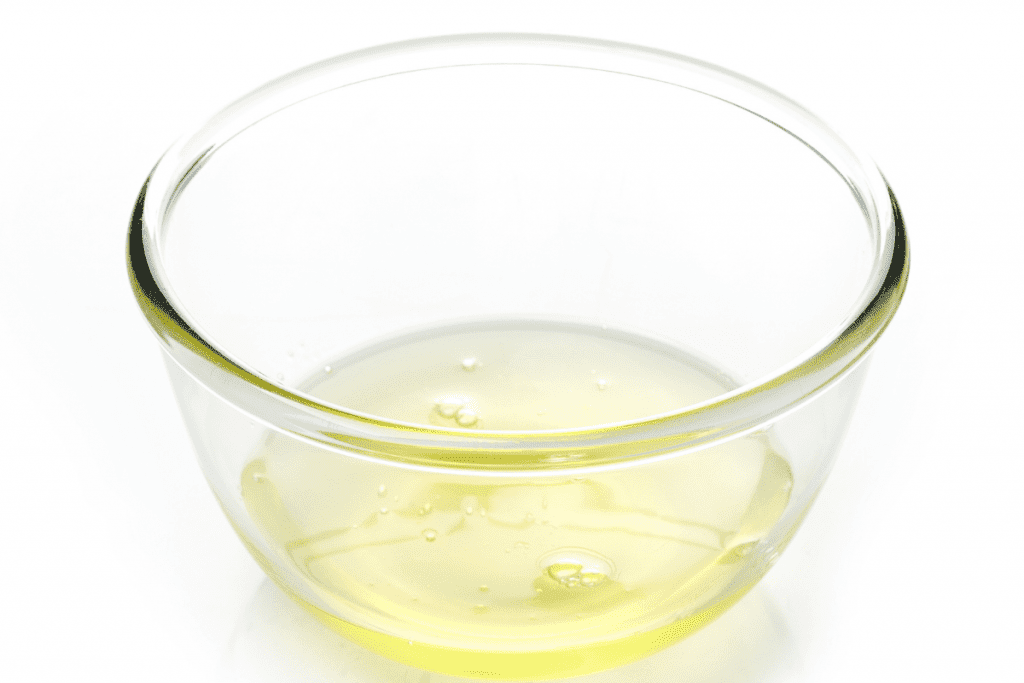If you keep chickens, you’ve likely experienced a strange egg or two throughout your daily collections.
Many factors contribute to the egg-laying cycle, and disruptions to the process cause abnormalities.
Abnormal chicken eggs commonly come out a little strange due to:
- Poor diet
- Stress
- Infections
- Environmental toxins
- Age
More often than not, abnormal eggs are not a reason for concern.
You may be wondering if the odd eggs are edible and safe for consumption.
We’ll go over 21 types of chicken egg abnormalities and what they mean to help you get your chickens laying healthy, delicious eggs.

Table of Contents
ToggleWhite-Banded Egg Shells
White-banded eggs are exactly how they sound.
Eggs with a white band around the shell result from calcium deposits occurring during the laying process.
The cause of this comes from two eggs coming into contact during the egg production process in the egg pouch.
Usually, white-banded eggs are nothing to be too concerned about.
Often they are caused by stressful events.
Many chicken keepers recall collecting white-banded eggs after particularly intense storms.
If you encounter one of these types of eggs in your coop, they are safe to eat and should be little cause for concern.
If it becomes a frequent problem, look into possible causes of persistent stress for your laying hens.
Small Eggs
During your collections from the nest, you may have encountered some eggs of abnormally small size.
Small eggs are usually completely safe for consumption and have little cause for concern.
Often small eggs are laid by young laying hens, also called pullets.
Young pullets sometimes produce abnormal eggs, usually smaller sized, as they get used to laying.
More often than not, the young pullets will produce normal-sized eggs after a few weeks.
If all of your laying hens are past their initial laying stage and still producing undersized eggs, you’ll want to investigate any causes for stress.
Stress is a common cause of undersized eggs in older hens.
Oddly Shaped Eggs
Eggs are usually fairly standard-shaped.
Sometimes we’ll get a slightly elongated or round egg and won’t be too concerned.
Other times we will get a truly strangely shaped egg and wonder if it is safe to eat or if our hens are healthy.
For the most part, oddly shaped eggs are safe to eat.
Abnormal chicken eggs change shape when the egg production or laying process is interrupted.
Some eggs have a curly end or tail formation on the shell.
Common causes for this particularly odd shape are stress and poor diet.
Other times it is caused by disease.
Be wary of curly shells with tails as they may indicate diseased hens.
Eggs With Multiple Yolks
Most of us have encountered eggs with multiple yolks.
Some chicken keepers report discovering as many as six yolks in a single egg.
The cause is usually rapid ovulation leading to multiple yolks.
Eggs with multiple yolks are usually fine to eat, and many keepers consume them regularly without encountering problems.
There is no real reason to be overly concerned if your laying hens produce multiple yolks in their eggs.
Young pullets at the beginning of the laying stages of their lives often produce double yolk eggs, as do older hens towards the end of their laying years.
Older hens often lay larger eggs and lay less frequently.
Yolkless Eggs
Alternatively to eggs with multiple yolks, you may encounter an egg without any yolk at all.
Sometimes these eggs are called “fairy eggs,” “fart eggs,” or “ghost eggs.”
Young pullets and older laying hens at either extreme age are more likely to produce eggs with no yolk.
Small pieces of tissue are treated as yolks, and the chicken builds an egg around the tissue.
If this is the case, you’ll notice small pieces of meat or tissue floating in the yolkless eggs.
Overall the yolkless egg should be safe to eat but may not taste good.
We recommend cooking and feeding pets or tossing them into the compost bin.
Dirty Eggs

Sometimes our chickens get into some mud after a big rainstorm leaving their nesting boxes dirty.
If they lay in the muck, the eggs will be dirty.
If the eggs are occasionally dirty from mud or feces, it is not a huge cause for concern.
But ff you are regularly encountering dirty eggs, you’ll need to address the cleanliness of your coop.
Dirty nesting boxes and coops contribute to disease, infections, and parasites.
Dirty eggs contaminated with feces and mud are more likely to be dangerous for consumption.
For the most part, cleaning dirty eggs makes them fit for consumption.
Some chicken owners will not eat the dirty eggs as there is some evidence water may push contaminants through the shell’s membrane.
Discolored Egg Whites
Discolored egg whites are a common indicator of laying hens eating something bad.
If you encounter discolored egg whites, survey the area in and around your chicken coop to ensure nothing is toxic or harmful.
Another common reason for off-colored and discolored egg whites is excessive seed oils.
To be safe, we do not recommend eating eggs with discolored whites as they may be contaminated.
Lash Eggs
Lash eggs, also called Salpingitis, are a matter of serious concern.
Lash eggs indicate a serious infection or disease in the laying hens.
Several different bacteria and viruses causing lash eggs, but the most common is E. Coli and salmonella.
Lash eggs are caused by inflammation of the oviducts responsible for egg production and laying.
The actual eggs take many forms.
Some have shells, while others are covered in a membrane.
The most distinguishing characteristic of lash eggs is a vile odor.
Lash eggs are inedible and often require immediate medical attention for the laying hen.
They are common in older hens and those bred for the mass production of eggs.
Pus from infection is treated as an egg in the production process and laid as a lash egg by the hen.
This is why lash eggs smell so terrible.
If you suspect your chickens may be laying lash eggs, we recommend veterinary treatment as soon as possible.
Strange Tasting Eggs
Sometimes when we crack open an egg from our coop, it just tastes a little off.
There are several reasons for the change in flavor, but the most common is dietary.
If chickens eat something out of the ordinary, it affects the taste of their eggs.
Many people report strange tastes similar to garlic from their eggs.
Some keepers believe this comes from overindulgence in garlic and onion plants by the laying hens, but more often than not, it comes from storing the eggs near garlic or onions in your kitchen.
Eggs are highly susceptible to absorbing odors through their porous shells after being laid.
Make sure to keep eggs away from potentially odorous foods.
Another common strange flavor experienced by chicken keepers is a fishy taste.
The fishy taste is often attributed to the flock’s overindulgence in fatty seed oils.
Strange tasting eggs are safe to eat for the most part unless the taste is particularly putrid or pungent.
We always recommend erring on the side of caution if you are unsure of the source of the smell.
It also helps to monitor what your chickens are eating to avoid overly fishy-tasting eggs.
Worm Infested Eggs
Worm-infested eggs are a particularly unsettling surprise.
If you crack open an egg and see a worm, chances are your stomach may do a bit of turning.
The worms are often visible in the egg whites and indicate your chicken has a worm infestation.
We recommend tossing the worm-infested eggs and going through a deworming treatment for the entire flock.
It also helps to deep clean the coop and nesting boxes and replace hay to deter a re-infestation and abnormal chicken eggs.
Discolored Egg Shells

Some breeds of chickens naturally lay different colored eggs.
Some of the shades are quite beautiful and pleasing to find in the nesting.
You may be a bit concerned if your chickens start to lay discolored eggs suddenly, especially if there are color changes on the same egg.
This change in pigmentation is no reason for concern most of the time.
Discolored eggshells usually have regular pigmentation for a portion of the egg, and the rest of the shell is white or a different color.
Often this is caused by stress from heat or other environmental factors.
Discolored eggshells are safe to eat.
There’s no need to worry unless it becomes a frequently recurring issue.
Pale Yolks
If you recently transitioned from store-bought eggs to farm-fresh eggs, you’ve likely noticed the difference in the color of the yolks.
Store-bought eggs tend to have more pale yolks than our farm-fresh varieties.
This is due to the poor nutrition common in factory farm chickens bred to lay massive quantities of eggs without their dietary needs met.
If your backyard chickens are laying eggs with pale yolks, it is a sign of poor nutrition.
Make sure to use high-quality feed and supplement with fresh fruits and vegetables.
There are also great vitamins to add to chicken feed to boost their nutritional profile and improve yolk quality and color.
White Yolks
Most people encounter pale yolks at one point or another.
Less commonly, you may encounter a white yolk with no pigment at all. Often white yolks are an indicator of worms.
Some chicken breeds produce white yolks by genetics, but if your chickens typically lay yellow yolked eggs, white yolks are a cause for concern and should be followed by a deworming treatment.
Off-colored Yolks
If you crack open an egg and notice an off-colored yolk, we don’t recommend eating it.
Often yolks get discolored due to ingestion of harmful materials by the chickens.
Like discolored egg whites, you’ll want to make sure your chickens aren’t getting into a plant or inedible material.
Eggs With No Shell
Sometimes our chickens lay eggs with no shells.
This happens when the shell fails to form, and the inner membrane contains the yolk and egg whites.
Most people encounter shell-less eggs during the early stages of egg-laying in young pullets.
Other causes include inadequate nutrition like calcium deficiency, stress, or diseases like Egg Drop disease.
If your chicken is young, there is little cause for concern, and your young hens will likely soon begin producing the hard shell.
No Membrane Eggs
Rarely will you encounter an egg with no membrane or shell at all.
In this case, you’ll find the yolk and egg whites in the nesting box.
This is very rare and should be little cause of concern if it happens at random and infrequently.
Many keepers believe this happens when egg production is interrupted by sudden stress forcing the hen to lay the egg before the membrane or shell develops.
Blood Stained Eggs
Occasionally you may encounter eggs with bloodstains on the shell in the nesting boxes.
This occurs in young pullets who have just begun to lay eggs most of the time.
If your chicken’s eggs start coming out blood-stained well into their laying stage of life, you’ll need to ensure no sign of injury on the hen.
Sometimes a prolapsed cloaca or vent pecking is the cause of the blood on the egg.
Soft Or Thin, Fragile Shells
Occasionally, we may encounter soft shells eggs or thin-shelled eggs.
Eggs with thin shells are fragile and may even be powdery enough to rub off.
Soft-shelled eggs and thin or fragile shells often indicate poor nutrition in the laying hen.
Older hens reaching the end of their laying stage tend to be the most likely to lay soft or thin, fragile eggs.
Other causes may be heat stress, moldy feed, and mineral imbalances.
Cloudy Egg Whites

If you crack open an egg from your coop and notice a cloudy egg white, there is little reason for concern.
You’ll most commonly notice this if you crack an egg right after collection.
The reason behind this is the warmth and gases still in the egg.
Most of the time, we allow eggs to cool before cooking them and do not see the process of the egg cooling down.
Before it cools down, there is no air sac, and the gases are still in the whites.
During the cooling process, the gases are released from the yolks and form the air pocket you see in the egg.
Cloudy egg whites are completely safe for consumption.
Pimpled Shells
As a chicken keeper, you may have noticed a pimple or two of flakey material on your eggs occasionally, but what if the whole shell is covered with these flaky pimples?
The pimpled shells are deposits of excess calcium on top of the shell.
The cause varies, but pimpled shells are common in older laying hens reaching the end of their laying stage.
If your chicken is still young, you may want to evaluate their diet and ensure their nutritional needs are met.
Calcium Balls
Like the pimples caused by excess calcium build-up, chicken eggs also get calcium balls.
They feel similar to the pimpled shell but form in sizable clusters on the shell.
These are most common in young chickens who’ve just started to lay and should even out over time.
The layer of calcium is easy to pick off and has little cause for concern.
Bumpy, Rough, Uneven Shells
If your chickens are laying rough and uneven shells, you’ll need to address the issue.
These eggs have rough ridges and are not the ovular shape we expect.
Causes include damage to the shell gland caused by prolonged infection from diseases like Newcastle and infectious bronchitis.
Other causes include side effects from medication or mineral deficiencies.
Meat Or Bloody Spots in Egg
Meat or blood spots in eggs might cause you some concern, but there is no real reason to worry.
Bloody or meat spots are caused by a blood vessel breaking during the egg production.
Though they may appear distasteful to those accustomed to store-bought eggs, they are perfectly safe to eat.
Luckily, the spots are quite small and easy to remove if you’d rather not eat them.
Sometimes the spots are caused by vitamin deficiencies, moldy feed, and genetics.
Spots like these are slightly more common in brown eggs.
Mottled Yolks
Mottled yolks are discolored and look unappetizing.
This occurs when the egg is stored improperly or affected by high temperatures.
Mottled yolked eggs are not safe to eat and should be discarded.
It is dangerous to store eggs at improper temperatures.
Other causes include stress, poor diet, antibiotics, and deworming medication.
Make sure you are collecting eggs regularly, especially in the hot summer months, to ensure the safety of your eggs.
It is also vital to evaluate their diet and remove any stress causes like heat or overcrowding.
Watery Egg Whites
The whites in eggs are the clear liquid inside the membrane surrounding the yolk.
Sometimes you may notice the whites appearing more watery than normal.
Many chicken keepers experience this when their eggs have been stored over an extended time.
Other keepers note experiencing more watery egg whites from hybrid breeds of chickens.
If you are suddenly experiencing more watery egg whites from your laying hens, you should address some common causes.
High ammonia levels from feces attributes to poor health and more liquidy egg whites.
Make sure the coop is properly cleaned and bedding replaced.
Other causes include age, improper storage, or heavy metals.
Most Common Causes Of Abnormal Chicken Eggs
If you are collecting abnormal eggs frequently from your coop, there are common causes to look out for.
Often, remedying the common causes is enough to promote the consistent laying of healthy eggs.
We recommend addressing the following common causes of abnormal eggs if your chickens frequently lay eggs with abnormalities.
Stress
Just like with humans, stress affects chickens. Flock stress negatively impacts the chickens’ health and is often reflected in the quality of their eggs.
The most common causes of stress are roosters, heat, and overcrowding.
Roosters stress out laying hens with mating attempts.
If you have roosters, make sure you have the proper ratio of hens to prevent stress to the laying hens.
Excessive heat also stresses laying hens and contributes to excess hydration leading to low-quality eggs.
Make sure your coop has adequate ventilation, and consider installing a solar-powered exhaust fan like this one to keep temperatures down during hot summer months.
Another common cause of stress is overcrowding in the coop.
Consider adding some nesting boxes if your coop is looking a little cramped.
Diet
One of the most common causes of poor quality and abnormal chicken eggs is poor diet and inadequate nutrition.
Often chicken feed lacks all the vitamins and minerals necessary for chicken health.
We recommend incorporating powdered vitamins and electrolytes like this to boost your flock’s health.
Allowing chickens to forage and free-range also allows them to find more diverse food sources and boost their health.
Parasites
Sick chickens do not lay high-quality eggs.
You are significantly more likely to encounter abnormalities in the eggs if your chicken suffers from parasites.
Chickens commonly stop laying when fighting off parasites, and when they do produce eggs, they suffer from abnormalities.
We recommend regularly treating your flock for worms and other parasites.
Age
Egg health often depends on how old the laying hen is.
Chickens go through different levels of egg production, depending on their age.
Young hens tend to lay smaller or blood-stained eggs, while older hens are more likely to lay fragile, thin-shelled eggs.
Is It Safe To Eat Abnormal Chicken Eggs?
Some egg abnormalities are completely safe to eat.
However, others are often an indication of disease or are more prone to contamination.
Common diseases include infectious bronchitis, salmonella, e. Coli, and Newcastle’s.
Make sure to research the exact abnormality you see to determine whether it is safe to eat.
If you are ever unsure, err on the side of caution and do not eat the abnormal egg.
How useful was this post?
Click on a star to rate it!
We are sorry that this post was not useful for you!
Let us improve this post!
Tell us how we can improve this post?
